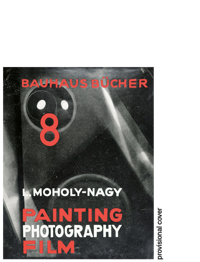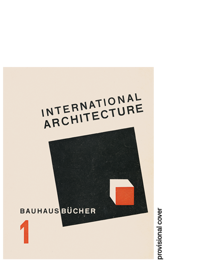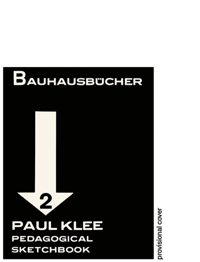THE BAUHAUS SERIES

Walter Gropius. International architecture.
In what he called his “illustrated guide to modern architecture,” which starts off the Bauhausbücher series, Gropius gives an overview of the international architecture of the mid-1920s. A preface by the author explores, briefly but in detail, the guiding principles that unite the avant-garde in all countries. This statement is followed by an extensive illustrated section showing examples of architecture from around the world. According to Gropius, these illustrations bear witness to the “development of a consistent worldview” that disposes of the prior role of the architect and expresses itself in a new language of shapes.
This first English translation of Volume 1 of the Bauhausbücher allows the reader to broaden his or her view of German architectural history by placing the achievements of the Bauhaus in an international context and by documenting and capturing its philosophy of reform in an illustrative way. It appears in original design and with separate commentary.
Walter Gropius (1888–1969) was the founder of the Bauhaus and a pioneer of modern architecture. In 1919, he was appointed to succeed Henry van de Velde as director of the School of Visual Arts in Weimar, which he renamed “Staatliches Bauhaus in Weimar”. In 1924, the Bauhaus moved to Dessau; Gropius designed the school building and the masters’ houses for the new location. In 1928, Gropius passed on the title of director to Swiss architect Hannes Meyer and became a self-employed architect in Berlin before emigrating to the United States in 1934. As a professor of architecture, he taught at Harvard University in Cambridge, Massachusetts, where he founded The Architects’ Collaborative in 1941. In his political efforts to industrialize construction and create desperately needed reseidential spaces, Gropius captured the spirit and influenced the work of numerous other architects.





Paul Klee. Pedagogical Sketchbook.
Active at the Bauhaus between 1920 and 1931, teaching in the bookbinding, stained glass and mural-painting workshops, Paul Klee (1879–1940) brought his expressive blend of color and line to the school—and, with the second volume in the Bauhausbücher series, beyond its walls.
In his legendary Pedagogical Sketchbook, Paul Klee takes a theoretical approach to drawing using geometric shapes and lines. Evincing a desire to reunite artistic design and craft, and written in a tone that oscillates between the seeming objectivity of the diagram, the rhetoric of science and mathematics, and an abstract, quasi-mystical intuition, Klee’s text expresses key aspects of the Bauhaus’ pedagogy and guiding philosophies. And while Klee’s method is deeply personal, in the context of the fundamentally multivocal Bauhaus, his individual approach to abstract form is typical in its idiosyncrasy. In this book, he presents his own theory about the relationships between line, shape, surface, and color in the visual space.
This English edition of Klee's book appears in original design and with separate commentary.
Paul Klee (1879–1940) was a German painter and graphic artist. Prior to his influential work at the Bauhaus, he was a member of the artists’ group Der Blaue Reiter. In 1914, while still working primarily as a draftsman and graphic artist, he traveled to Tunis with two fellow artists; their journey is considered by art historians to be a key event in German modern art. It was this journey that enabled Klee’s international breakthrough as a painter. From 1920 to 1931, Klee was active at the Bauhaus until offered a professorship at the Art Academy in Düsseldorf. After Hitler took power, Klee and his family emigrated to Bern. In 1937, numerous works of his were displayed at the Degenerate Art exhibition, then confiscated and sold abroad. In 1940, about four months prior to Klee’s death, the Kunsthaus Zürich hosted an anniversary exhibition of the artist’s later works.
Paul Klee’s extensive oeuvre and his writings on art theory make him one of the most important practitioners of 20th-century early modern art. 






Piet Mondrian. New Design - Neoplasticism.
Although Piet Mondrian was not an active member of the Bauhaus, his name is often mentioned in connection with the art school. Starting with a philosophical foray in which he describes art as a figurative expression of human existence, Mondrian embeds his concept of a New Design in the various forms of artistic expression. He looks into the question of whether there is a prevailing hierarchy between painting and architecture and dares to take a far-reaching look at the future of neoplasticism.
This complete English edition appears in original design and with separate commentary.
Piet Mondrian (1872–1944) was a Dutch painter who became known internationally as the founder of the De Stijl artistic movement. Prior to touting neoplasticism in his writings on art theory, Mondrian encountered cubism in Paris, his adopted home, which had a significant effect on his artistic work. His firm conviction of abstract painting continued even after he emigrated to the United States in 1940, leading him to join the American Abstract Artists in New York. Almost until his death, Mondrian continued to publish essays on art theory in which he dealt intensively with neoplasticism and abstraction in painting. 





Laszlo Moholy-Nagy Painting. Photography. Film.
Moholy-Nagy’s efforts to have photography and filmmaking recognized as means of artistic design on the same level as painting are propounded and explained at length. The use of artistic instruments is thus radically reformed. The Hungarian artist makes the case for a functional transformation within the visual arts and for the further development of photographic design options.
Alongside theoretical and technical approaches as well as detailed forays into the broad field of the medium of photography, Moholy-Nagy uses an extensive appendix of illustrations to provide a thorough survey of the numerous possibilities that photographic and cinematic work had in store as early as 1925.
This English edition appears in original design and with separate commentary.
László Moholy-Nagy was born in southern Hungary in 1895. After unfinished law studies and military service during the First World War, he attended an evening art school, which marked the beginning of his career as an artist. During his first artistic years his style of art was much influenced and shifted from the figurative to a
short Dadaist phase before it became completely abstract. His earlier paintings, which were strongly
influenced by Russian Constructivism, already illustrate his life-long preoccupation with light and transparency. Around 1922 Moholy-Nagy became aware of the photogram and the artistic potential of the motion picture, which fascinated him for the rest of his life. When he moved to Berlin two years later, he met Walter Gropius, director of the Bauhaus, who visited Moholy-Nagy’s exhibition at the avant-garde art gallery Der Sturm. He appointed Moholy-Nagy as a teacher at the art school in Weimar in March 1923. The artist remained loyal to the Bauhaus even after its move to Dessau, before he finally left it in 1928.
After Hitler seized power in 1933 it became more and more difficult for Moholy-Nagy and many other avant-garde artists to work in Germany. In 1934, one year after his participation in the 4th CIAM Congress in Athens, he accepted a job offer from a design company in Amsterdam and moved to Holland. In 1937 Moholy-Nagy opened “the new bauhaus: American School of Design” in Chicago, which already had to be closed after one year due to financial difficulties. In February of 1939 he was able to open a successor institute, which he called “The School of Design in Chicago,” today known as “IIT Institute of Design.”
In December of 1945, Moholy-Nagy was diagnosed with leukemia and died on 24 November 1946 at the premature age of 51.





Bauhaus Journal 1926-1931
One hundred years after the founding of Bauhaus, it’s time to revisit bauhaus journal as significant written testimony of this iconic movement of modern art. In this journal, published periodically from 1926 to 1931, the most important voices of the movement are heard: masters of the Bauhaus, among others, Josef Albers, Walter Gropius, Wassily Kandinsky, Paul Klee, László Moholy-Nagy, and Oskar Schlemmer, as well as Herbert Bayer, Marcel Breuer, Ludwig Mies van der Rohe, Gerrit Rietveld and many more.
They address the developments in and around the Bauhaus, the methods and focal points of their own teaching, and current projects of students and masters. At the time primarily addressed to the members of the “circle of friends of the bauhaus,” the journal published by Gropius and Moholy-Nagy makes tangible the authentic voice of this mouthpiece of the avant-garde. The facsimile reprint is intended to give new impetus to international discussion and research on the Bauhaus, its theories and designs.
The exact replica of all individual issues are accompanied by a commentary booklet including an overview of the content, an English translation of all texts, and a scholarly essay which places the journal in its historical context.







